What is legal to photograph outdoors?
Going on a trip and bringing a camera along? — Great! However, be sure to know what you can photograph at your destination without breaking the law. The short answer to what is legal, is: it very much depends.
You may want to rotate your phone in order to improve your browsing experience on this site.

Disclaimer: The following isn't meant to replace professional legal advice. The information gives an overview of issues which may arise in connection with your photographic activity. In doubt, consult a lawyer.
Quick link
Photography and copyright
If you are a professional photographer or trying to establish yourself as one, protecting rights over your creative output should be of major concern to you.
If it never appeared to you yet, the time is now.
If you think about it, it is of the same significance for any copyright owner.
If you think about it further, your photography can violate these rights, too.
Sure, as a landscape photographer you are free to choose your subjects at will most of the time, that is, while staying on public ground and aiming your camera at the same.
This changes when you enter a city.
City lights
Within city limits, or in any populated area, you are surrounded by private property. Its legal owners also reserve the copyright, in general. Whether your photography infringes on it or not, is a matter of local laws in the country where you are.
Some legal systems make exceptions for photography and other visual arts in their copyright laws. These exceptions allow, under certain conditions, replication of private property in works of art, including photographs.
Exceptions can, in turn, be restricted and apply to certain kinds of subjects only, for example, buildings, making other subjects, like street art, fall under copyright again.
Provisions limiting the copyright laws are known as Freedom of Panorama in English. The term is a literal translation from German, where it sounds just as awkward. German Empire was the first state to introduce the legislation allowing reproduction of plastic arts permanently stationed in public areas. This happened as early as 1876. In 1907, a reformed law became effective, which explicitly mentioned photographs of buildings and monuments in public places as exempt from copyright.
In other countries, no such provisions are made, and photography, especially commercial photography, is subject to the same penalties as other copyright infringement practices.
The current legal state around the world and in Europe is presented on the following maps:
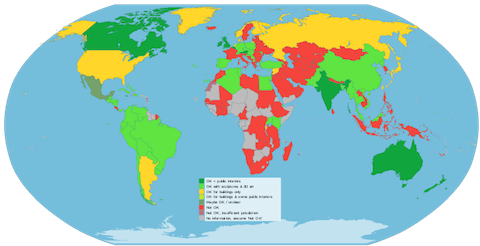 Where in the world...
Where in the world...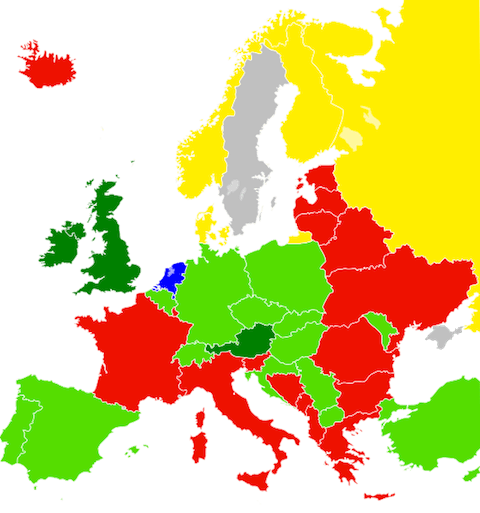 ...and in Europe you are free to photograph in public places
...and in Europe you are free to photograph in public placesImages by Mardus and Quibik, respectively, via Wikimedia Commons
The Netherlands: Public interiors are OK, but schools, opera buildings, museums, and entrance halls of businesses are not considered public places by Dutch law
The colours on both maps are not exactly the same, but you can easily match them. Mexico on the world map is "Maybe OK, unclear", so should actually be grey.
The full colour palette in use by the European Union may cause surprise, but its member states rarely disagree on something more than they do on copyright.
In fact, young Members of European Parliament tried to harmonise Freedom of Panorama provisions across the Union. The idea was to make liberal legislation common sense. It turned out differently. The working group ended up with a bill requiring "green" countries turn red instead. The Parliament did well, though, and turned the motion down (for now).
What does it mean for you?
Good question! In general,
- Dark green countries are most liberal. You can usually take pictures of everything in public places and public interiors. In Austria, you can photograph all objects standing in public even from private ground, for example, from a hotel room or an apartment. Some restrictions may still apply for street art, paintings, books, etc.
- Light green means OK to photograph buildings, monuments, sculptures, or the like, which are permanently installed in outdoor public areas. Objects of art placed, say, in a park during a temporary exhibition, are usually off-limits.
- Yellow countries allow you to photograph buildings only. Monuments and sculptures are subject to usual local copyright laws. United States define "buildings" only as such; bridges, damns, interchanges, and intersections fall under copyright protection.
- Red is red, no commercial photography of copyrighted objects is allowed. (Private, non-commercial use of images is sometimes illegal, too.)
A quick look on the maps will give you an answer what you can expect to be able to photograph at your destination. However, this is only one part of the story.
Even in "green" countries – or especially in those – mind anti-terror measures as well. Choose your motifs with due sensibility. You don't want to be accused on these grounds.
One more thing... or two
There is at least one more variable in the equation: the laws of your own country of residence. You can be held liable according to them, if they happen to be stricter than those where you took your photographs.
The German Federal Court of Justice decided in 2003 against the legality of selling prints made from photographs taken in Vienna, Austria. The images of a building by the Austrian architect Friedensreich Hundertwasser were taken without his permission from a private apartment in an opposite building. Though in accordance with "dark green" Austrian law, they were against the "light green" German provisions. The business group trying to sell the prints was successfully sued at the location of its headquarters in Germany.
To make it even more complicated, if the copyright owner is from a third country, its legislation is also to be taken into account.
Oh, and don't forget: if you publish someone else's photographs on your web site or blog, you are still liable in case the images infringe any copyright.
Now, what to photograph in Paris?
Another good question! This is a kind of research you should make before a visit to any "restricted area".
According to French law, only images of buildings and works of sculpture taken by individuals without commercial intent in public areas, are exempt from copyright. Street art and exhibition objects are, on the other hand, not.
Eiffel Tower is a notable exception, since Gustave Eiffel yielded his copyright to public domain. SETE, the organisation in charge of the monument, still claims copyright for images of illuminated Tower in France and several other countries.
For everything else, as I see it – and this is in no way official –, these are your options:
- Ask for permission. This is the surest way to stay legal.
- Use wide shots. Even the most forbidden features become less prominent when looked at from a distance.
- Pretend your image is about something else. Compose it in such a way that changes its subject, moves it in the background, out of focus, or in part out of frame.
- Photograph a reflection instead. Make the real thing recognisable, but not obvious.
- Leave the town. Return to the outdoors — the nature is the most talented creator, and doesn't claim copyright, thankfully 😌
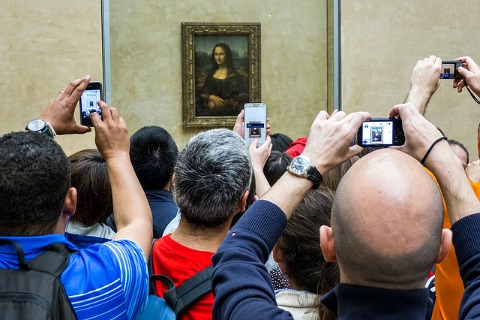
France is just an example, being one of the most popular tourist destinations in Europe. Italy is another one where you should pay attention.
"Pay" seems the right word to use in this context.
Tags: #photographylegal #copyright #photographytips
Other landscape photography tips
- Landscape photography composition tips
- Your mastery of photography composition is what ultimately makes your images. Read here how to excel at it in order to engage your viewers!
- Black & white landscape photography
- Black-and-white photography is very much alive, and landscapes in black and white still look as stunning as in Ansel Adams's day. Be sure to check the article if you'd like to try your hand at this classic and fascinating technique.
- Landscape photography equipment essentials
- Looking for a new camera or another piece of gear? Find answers to your questions, along with some advice and recommendations!
- Fine art photography prints
- And now for something completely different… My thoughts and advice on choosing and using fine art photography prints.
- How to photograph waterfalls
- If your waterfall images are not up to the expectations of your friends, nor to your own satisfaction, try these easy to follow tips to make them shine!
- Marketing fine art photography
- This newsletter issue is about creating your brand and marketing your work, told by those who've been there and done exactly that.
- What is legal to photograph outdoors
- Ever thought about copyright laws having two sides? Your photography can violate them, too. Be sure to know what to photograph, where without getting into trouble.
- How to use Photoshop
- In a dedicated newsletter issue, join me as I show how I use Photoshop to edit my images, and learn some funny facts about the application while at it.
- Wildlife photography tips
- No purchase necessary: Learn how to photograph wildlife for best possible results with your usual equipment.
- Art seascapes
- As November closes in, we take Ishmael's, of Moby Dick, advice and get to sea as soon as we can, led by some highly inspirational examples.
- Winter landscape photography tips
- "Winter landscape" may not sound as exciting as, say, "summer beach", not to everybody, for sure. But if it does to you, there is much to discover outdoors in this time of the year, too. Dress warmly and come on outside!
- Best Adobe Photoshop tips
- We recall some Photoshop basics, like layers, and proceed with more advanced topics, like masks, selective channel editing, converting colour to black and white, and output sharpening.
Unattributed images on this page are sourced from Pixabay and Wikimedia Commons.
Tell me what you think!
Is it useful 👍? Awful 👎? Leave a message! Your comments help make this site better (and give me a kick—one way or another).
Popular articles
-
A kind of magic
If a digital picture has to be seen in the real world, printed on a real medium and displayed in a real showcase, its transition from RAW to real is better done in an old school image editor. Enter A…
-
A duck for a dog
If you got your own place on the Internet, helping your visitors find what they are looking for is a great way to engage them and keep them staying a bit longer. A custom site search can achieve just …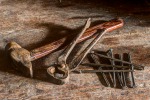
-
"Might as well have the best"
Aiming for better images? Think better lenses! This is your most important piece of gear, so you better get it sorted out. — Need some advice?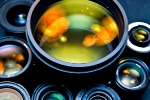
 Become a patron for
Become a patron for